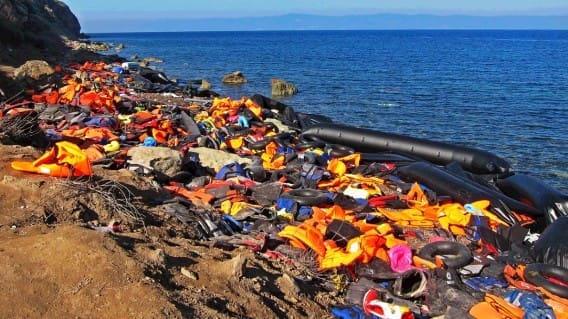

Migration: Studie über den von der Regierung finanzierten „Pullfaktor“ genau wie gewünscht
Von Kai Jäger. ZDF-heute titelte „No pull effect through sea rescue“, the Süddeutsche wrote „No evidence for the pull factor thesis“ and the Tagesschau knew: „Pull factors are greatly overestimated“. The reason for the headlines was a study funded by the German government, which examined whether the presence of sea rescuers in the central Mediterranean encourages migrants to make the dangerous crossing. Now it turns out: The study was designed in such a way that the politically desired results were predetermined from the beginning. It is unusual for a scientific article that over 150 newspapers in Germany and abroad report on the study results shortly after its publication. This was the case last week after the renowned journal Scientific Reports published the article „Search-and-rescue in the Central Mediterranean Route does not induce migration: Predictive modeling to answer causal queries in migration research“ online. The study by authors Alejandra Rodríguez Sánchez, Julian Wucherpfennig, Ramona Rischke and Stefano Maria Iacus was conducted as part of a project of the pro-migrant DeZIM Institute and was financially supported by the German Research Foundation (DFG). The explosiveness is already in the title, because the study is supposed to show that sea rescue in the Mediterranean does not lead to more migrant crossings to Europe. Furthermore, the presence of sea rescue does not lead to more deaths in the Mediterranean, but saves lives. Accordingly, the media resonance was positive and uncritical; „The findings refute arguments from populists,“ according to ZDF. The study is listed among the top 0.1 percent of all scientific articles in terms of attention in social media at Altmetric. A rudimentary look at the article is enough But apparently neither journalists nor scientists have read the study more closely. Because even a rudimentary look at the article is sufficient, even without scientific knowledge of methods, to see that something is not right with this study. Let’s first take a look at the data as presented by the researchers. These graphs show the number of irregular crossings in A. and the mortality rate of refugees who died at sea in B. for the periods of sea rescue. Let’s first look at the lower part B. At first glance, the mortality rate in 2019 seems to be higher than in the shaded area representing the peak of sea rescue. The authors also state on page 3 that „the absence of sea rescue and the beginning of coordinated pushbacks are associated with a higher estimated mortality rate“. However, what is noticeable here is that the authors do not use the absolute number of deaths of refugees drowned in the Mediterranean, but rely on a specially constructed measurement of the mortality rate. This measurement divides the number of deaths by 100 or 1,000 attempted crossings. However, the absolute number of deaths is the crucial number that needs to be reduced – and therefore relevant from a political point of view. Constructed mortality rates The use of constructed mortality rates apparently serves to hide the fact that most deaths at sea occurred during the „heyday“ of sea rescue, as we can see from the official data at Statista (2014: 3,286 / 2015: 4,055 / 2016: 5,163 / 2017: 3,139 / 2018: 2,337 / 2019: 1,885 / 2020: 1,449 / 2021 2,062 / 2022: 2,406 / 2023: 1,875). Thus, the absolute number of deaths in 2023 with 1,885 was lower than in previous years. Appropriately, the authors do not mention the absolute number of deaths anywhere in the article, as the absolute number of deaths is difficult to reconcile with the claim that sea rescue saves lives. In the upper part A, we also clearly see that the attempts to cross during the „heyday“ of sea rescue were highest. All strong increases and peak numbers of crossings fell into the months of sea rescue. This seems to contradict the main result of the article, which raises the question of why the researchers cannot find a connection between sea rescue and crossings. The project is not an empirical study in the classical sense, but a predictive analysis or a predictive model: The researchers looked at the period before state and private sea rescue and trained a data-driven artificial intelligence (AI) using various data sets to develop a model that can best explain the irregular crossing attempts during this period. Data and predictions from the fairy tale book This model is then used to predict the irregular crossing attempts during the period of sea rescue. Finally, this prediction is compared with the actual crossing numbers and estimated whether there is a significant difference between the counterfactual and actual crossing attempts. In their model, no significant difference was found, which is why Rodríguez Sánchez and colleagues concluded that sea rescue does not represent a pull factor for migration flows. I have already criticized the predictive analysis in two scientific articles, see here and here. I show that a study published in the renowned American Journal of Political Science was based on incorrect data and predictions from the fairy tale book. Curiously, one of the authors of the former study was Nils Metternich, a regular co-author of Julian Wucherpfennig, who was involved in the DeZIM study. I would like to highlight two general problems with such predictive models. First, the data-driven AI recognizes which variables are closely correlated with the phenomenon to be explained, but not whether they are spurious relationships. Think, for example, of „Mierscheid’s Law,“ which uses West German steel production to successfully „predict“ the election results of the SPD. The more complex the model, the more the prediction becomes a „black box“: There is a high statistical prediction rate, but without the gain of knowledge about what this is specifically due to. The DeZIM study uses various standard data and alternative data for the prediction, such as how often Google was searched for after the Syria conflict or for job opportunities in Arabic, the number of passengers at selected European, African and Asian airports, or the exchange rates of currencies from selected countries
Original Artikel Teaser
Migration: Regierungsfinanzierte „Pullfaktor-Studie” wie bestellt
Von Kai Jäger. ZDF-heute titelte „Kein Pull-Effekt durch Seenotrettung“, die Süddeutsche schrieb „Kein Beweis für die Pull-Faktor-These“ und die Tagesschau wusste: „Pull-Faktoren werden deutlich überschätzt“. Anlass für die Schlagzeilen war eine von der Bundesregierung finanzierte Studie, die untersuchte, ob die Präsenz von Seenotrettern im zentralen Mittelmeer Migranten ermutigt, sich auf die gefährliche Überfahrt zu machen. Jetzt stellt sich heraus: Die Studie war so angelegt, dass die politisch erwünschten Ergebnisse von vornherein feststanden. Es ist außergewöhnlich für einen wissenschaftlichen Artikel, dass bereits kurz nach dem Erscheinen über 150 Zeitungen im In- und Ausland über die Studienergebnisse berichten. Dies war vergangene Woche der Fall, nachdem das renommierte Journal Scientific Reports den Artikel „Search‑and‑rescue in the Central Mediterranean Route does not induce migration: Predictive modeling to answer causal
Details zu Migration: Regierungsfinanzierte „Pullfaktor-Studie” wie bestellt









